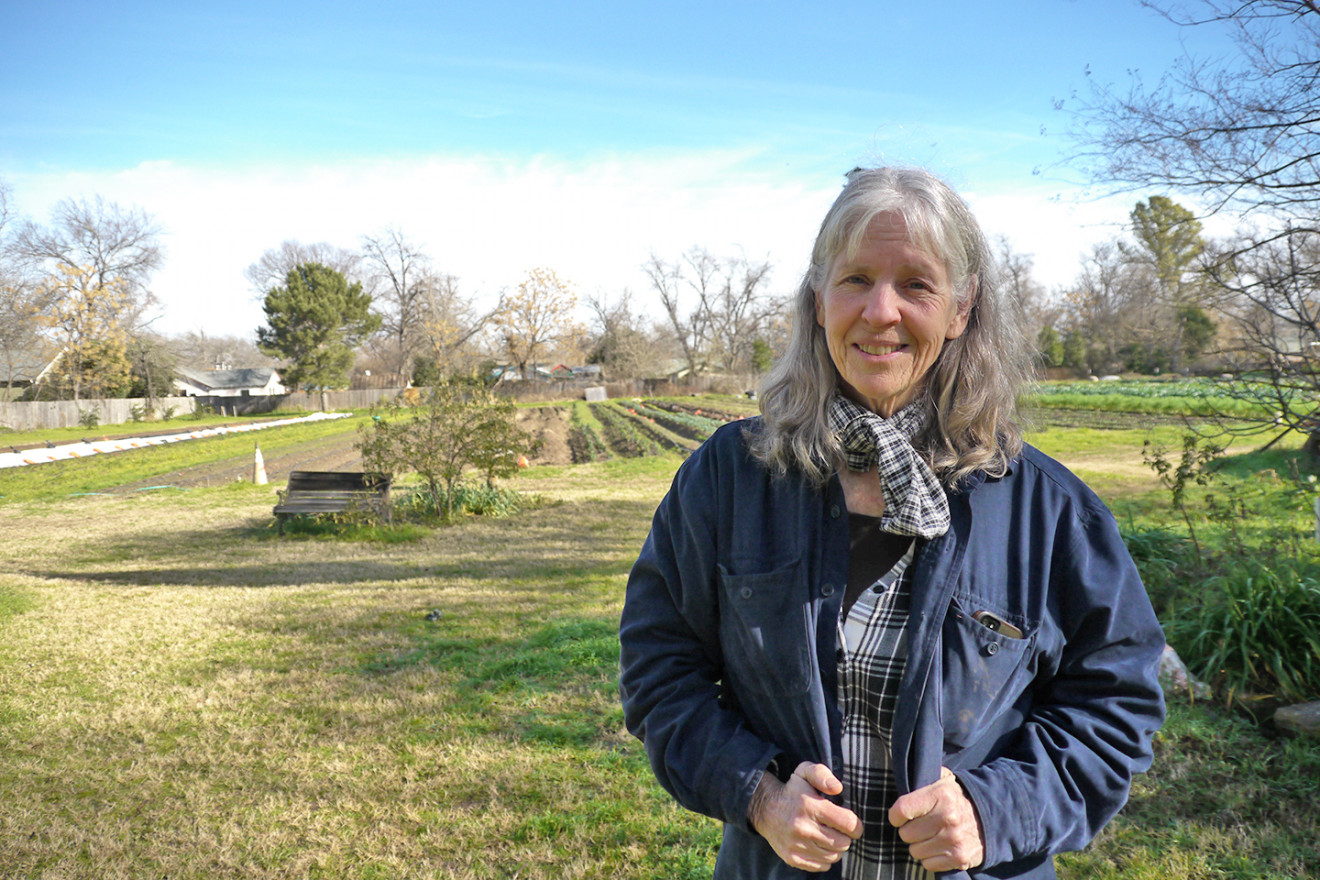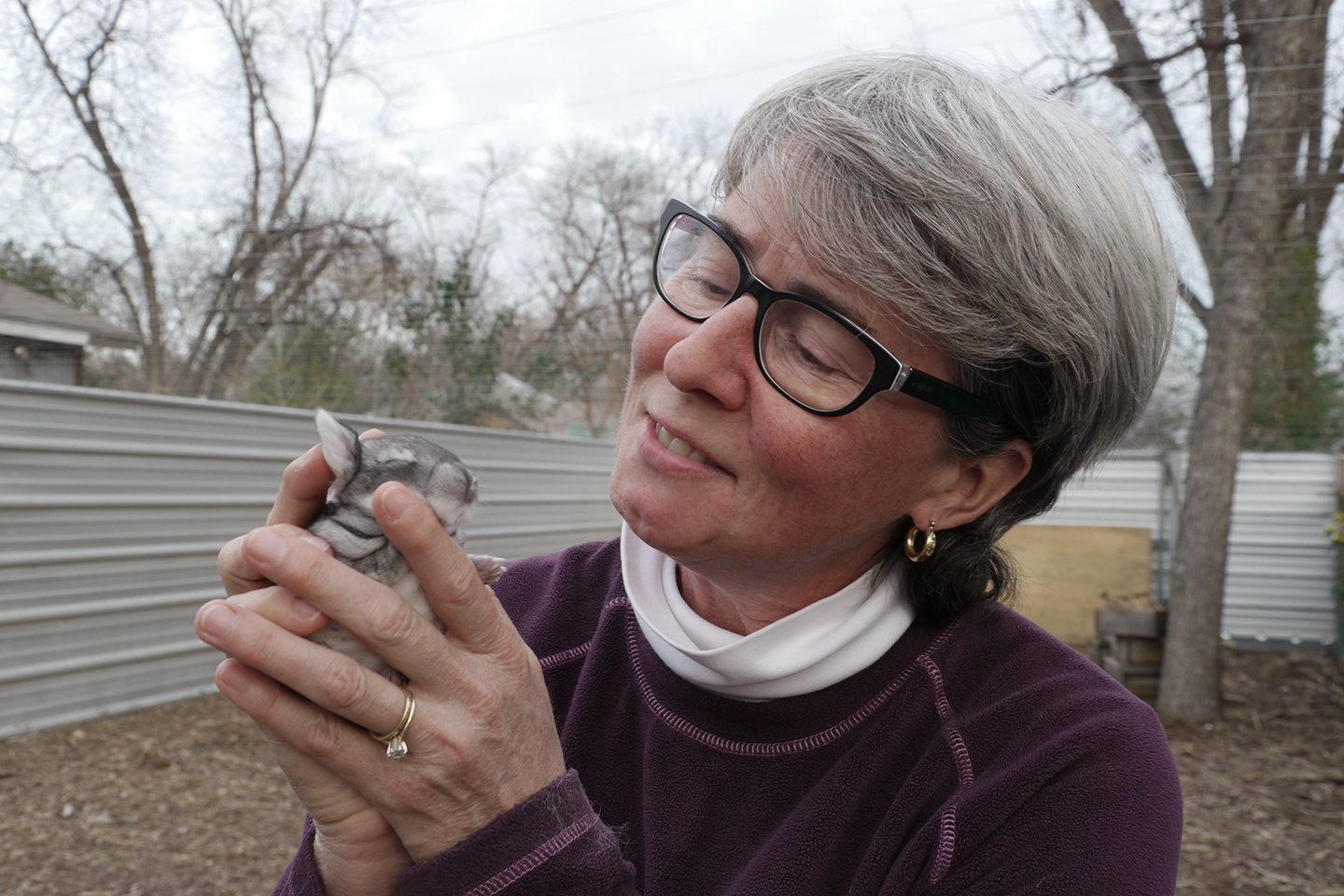
When Carol Anne Sayle began farming with her husband Larry Butler in 1981, they were ahead of their time as urban farmers. They also became early voices in the locavore movement in Austin, Texas. (Eva Legge/Dartmouth College)

When Carol Anne Sayle began farming with her husband Larry Butler in 1981, they were ahead of their time as urban farmers. They also became early voices in the locavore movement in Austin, Texas. (Eva Legge/Dartmouth College)
Even with dozens of volunteers and employees, Carol Ann Sayle still likes to arrange her own bouquets. Each one is different — some are blood red and lemon yellow, while others blush a pastel pink. The bundles of wisteria and zinnia can be found in the center of the urban farm stand every Saturday morning, surrounded by bunches of spicy arugula, barrels of sweet cherry tomatoes, and jars of homemade sauerkraut. Carol Ann flits among her customers, addressing many by name and asking them how they’ve been in the week elapsed since their last visit. It’s easy to see that she is not suited to mask-wearing; every time it slips down her small nose she rams it upward with an annoyed jolt of her sun-freckled hand. But the cloth mask has little effect against Carol Ann’s spirits. Even in the midst of the COVID-19 pandemic, the Boggy Creek Farmstand is as busy as ever. Carol Ann is used to weathering change with grace, and she has had many years to practice. After all, Boggy Creek is Austin, Texas’ first urban farm.
***
In 1981, Carol Anne Sayle and her husband Larry Butler began farming in Milam County, an Austin suburb. They sold produce to Whole Foods, a local grocery store, and opened a small farm stand in front of Wiggy’s Liquor Store in Clarksville, Texas. Sayle and Butler were not only ahead of their time as urban farmers, but also as early voices in Austin’s locavore movement, encouraging Austin residents to see the benefits of eating locally.
“When we first started selling in front of the liquor store, we had to explain what ‘organic’ meant,” Sayle said with a smile.
Although Milam County farm thrived, it was a long drive to Austin to sell their produce. In 1992, Sayle found a five acre piece of fertile land in the Boggy Creek watershed, and their urban farm was born.
“We found this property, and we thought ‘Ooh!… this would be a farm’,” Sayle said. “We could make it a farm, and we could live in the farmhouse, and just step right out the door and go to work! This is great!”
***
Nearly two decades later, but just around the corner from Boggy Creek farms, a former restaurant owner named Dorsey Barger had a similar vision. Faced with an empty, two-acre farm in the heart of East Austin, she saw an opportunity to sow and harvest. Her vision became reality. Hundreds of chickens provide fresh eggs to the farm. Baby bunnies abound, and a pet goose named Gustavo quacks amicably at passers-by.

The farm, named HausBar, is an ideal model for many who dream of sustainable food systems. Barger has a rainwater collection bin that has 30,000 gallons of storage capacity, which they use to irrigate their crops. According to their website, they are currently expanding their solar panel capacity, so that 90% of their electrical needs will be powered by the sun. And, perhaps most delightfully, Barger uses donkeys instead of lawn mowers to mow and fertilize the pasture.
To top it off, Barger is often credited with spearheading Austin’s locavore movement. “People often say to us that we…. really started the locavore movement in Austin,” Barger said. “I do think that we did; we were there at the beginning, of what became, I think now, a true locavore movement.”
But before Barger opened the farm in 2009, things looked much different.
“It was pretty much two acres of trash with three crack houses on it,” Barger said. “We figured if we just cleaned the place up enough… it would be something pretty amazing here.” After purchasing the property, Barger embarked on a seemingly impossible task.
“In our quest to be sustainable we wanted everything to be improved by our being here, so we dug the 51 beds of vegetables that you see out there, with pitchforks and shovels, instead of tillers and trucks,” Barger said with an expression that she still could not believe what she accomplished.
***
Both Barger and Sayle started their respective farms for one principal reason — they believed in the importance of locally grown food.
“The reason we wanted to do it was to give people good, clean food,” Sayle said. “If you don’t have fresh food, it’s worthless… (our) arugula is sparky and fierce.. but in the store, it was just, ‘bleh!, this is arugula?’ It’s flavor, see. There’s no flavor there, and there’s flavor here, and that flavor tells you that it’s fresh.”
The minute a vegetable or fruit is picked off the plant, the flavor starts to fade away. And flavor, Sayle explained, is a direct indicator of nutrition. The C, E, A, and some B vitamins deteriorate over the days, or even weeks, it takes to pick, package, and ship produce all over the world.
“In California or in Chile or China or wherever that vegetable in the store came from, it was probably once wonderful,” Sayle said. “But when you go through refrigeration — almost freezing, for weeks on end — it all goes away.”
According to Barger, local produce is vital not just for the health of Austinites, but for the health of the planet and the local economy.
“There’s so much pollution that goes on in bringing that organic produce from California, to Texas, let’s say, that it’s not enough just to eat organically,” Barger said. “Not only is it it not enough for pollution reasons, but it’s also not enough because it doesn’t make any sense to depend on somebody else for your food, and so we need to be supporting local farmers.”
When one buys produce from a grocery store, a very small percentage of revenue goes to the farmer, Barger explained. The rest of the profit the packager, the middlemen, and the processor. But when a customer buys produce from a farm, most of the revenue goes directly to the farmer. That farmer will have much more money to spend in the same economy.
“By spending locally we are actually supporting everyone who lives in our area,” Barger said.
***
In the midst of a global pandemic and a plummeting economy, it is vital now, more than ever, to invest both in local businesses and in our own well-being. Visiting your local farm can have that dual benefit. And on a cool October morning, nothing is more pleasant than to wake up early, drive across town, and walk among rows of dew-flecked kale. Nothing is more uplifting than to gather with friends, neighbors, and strangers, all distanced during the pandemic, but united by their love of Carol Ann’s flowers. That, I believe, is well-worth the mask.